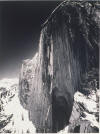
Pre-visualization
Ansel Adams introduced the idea of pre-visualization into the photographer's lexicon; a term he used to label the importance of imagining, in your mind's eye, what you want the final print to reveal about a subject. Without this preconception, wherein much of the artist's creativity resides (specifically, in the implicit steps that must be followed, starting with composition, focal length, shutter speed, filtration, and so on, in order to achieve the pre-visualized image), the resulting "photograph" is at best a product of inspired "luck" (or intuition) and, at worst, shallow and unable to communicate meaning.
A common complaint of many of today's amateur photographers is that their camera simply doesn't produce the kind of pictures they want; or, though it is rarely stated this way, doesn't produce what they see in their head!
The reality, of course, is that
no camera, however sophisticated, can
guess what is in the artist's mind, and then, having correctly guessed, perform
whatever digital manipulations are required to produce the "perfect" digital
file; a file that, moreover, must then also be
printed correctly on some chosen combination of printer and paper. It is
ironic that as the power of our tools (including cameras, software and printers)
increases, and becomes more affordable and user-friendly, the desire to
use our tools (to convert a simple point
& shoot image into a photograph that more closely resembles an inner vision)
generally declines. We expect more out
of our cameras; and when the camera (through no fault of its own or its
manufacturer) inevitably fails to deliver what we demand, we just as inevitably
blame the technology.
The simple lesson of pre-visualization - that is as
applicable today as when Ansel Adams was capturing his spectacular images of
Yosemite National Park - is that while one
might get lucky, and capture a fine image, the far more likely result of
approaching a subject without an idea already in mind is disappointment.
Fine art does not just
happen; it requires a act of
inspired, participatory creation. The
artist must be a willing and active participant in
all of the steps leading up to the
image's final form; including the act of capture and the digital tonal
manipulations.
Case in point: consider the three images.
Despite the fact that the three images are visual
imprints of the same thing (a fire
plug), no one will argue that they are very
different!
I can confidently assert that the third image is precisely what was in mind when I pressed the shutter.
More to the point, the objectively rather bland before image of the plug was very faithfully rendered by my camera. But it is not what I wanted the image to look like, and which I knew I could create by having pre-visualized the process necessary to get there at the instant I pressed the shutter. The bland before image simply needed a "bit of work" to get it from its "faithful" form, into a state in which I am satisfied that it (at least) stands a chance of communicating a bit of my aesthetic view.
A nice way to summarize these musings, and as an homage to another of Adams' favorite sayings, is to think of the camera's output as an "equivalent" of a musical score (the image "exists" but in an essentially latent, as-yet-unrealized form); what the photographer subsequently does with that RAW file in the digital darkroom is analogous to a performance! (The "performance" can - indeed, undoubtly will - change in time as the photographer's own skills, tastes and "eye" evolve. If there is a single deep lesson that photography teaches us, it is that there is no such thing as the one "true" objective reality.
http://www.shutterbug.com/techniques/digital_darkroom/